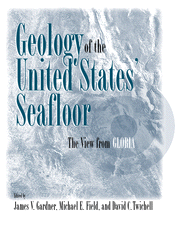Book contents
- Frontmatter
- Contents
- Contributors
- Foreword
- Introduction
- Part I The GLORIA System and Data Processing
- Part II U. S. East Coast EEZ
- Part III Gulf of Mexico and Caribbean EEZ
- Part IV U. S. West Coast EEZ
- Introduction
- 10 Discrimination of Fluid Seeps on the Convergent Oregon Continental Margin with GLORIA Imagery
- 11 A Meandering Channel at the Base of the Gorda Escarpment
- 12 The Morphology, Processes, and Evolution of Monterey Fan: A Revisit
- 13 Ground-Truth Studies of West Coast and Gulf of Mexico Submarine Fans
- 14 Morphology of Small Submarine Fans, Inner California Continental Borderland
- Part V Alaskan EEZ
- Index
14 - Morphology of Small Submarine Fans, Inner California Continental Borderland
Published online by Cambridge University Press: 25 January 2010
- Frontmatter
- Contents
- Contributors
- Foreword
- Introduction
- Part I The GLORIA System and Data Processing
- Part II U. S. East Coast EEZ
- Part III Gulf of Mexico and Caribbean EEZ
- Part IV U. S. West Coast EEZ
- Introduction
- 10 Discrimination of Fluid Seeps on the Convergent Oregon Continental Margin with GLORIA Imagery
- 11 A Meandering Channel at the Base of the Gorda Escarpment
- 12 The Morphology, Processes, and Evolution of Monterey Fan: A Revisit
- 13 Ground-Truth Studies of West Coast and Gulf of Mexico Submarine Fans
- 14 Morphology of Small Submarine Fans, Inner California Continental Borderland
- Part V Alaskan EEZ
- Index
Summary
Abstract
Long-range sidescan sonographs from the GLORIA sidescan sonar system provide a new perspective on the morphology and sediment distribution of small active submarine fans in the Santa Monica and San Pedro Basins of the California Continental Borderland. These sonographs, combined with 3.5-kHz seismic-reflection profiles, depict elongate submarine fan systems characterized by intermediate acoustic backscatter in the middle fan region and low backscatter in the distal reaches where the lower fan feeds onto the high-backscatter central basin plain. The fans are fed by low-backscatter channels that originate in shallow water at the northwest corner of each basin. These channels subsequently branch downstream into a system of smaller channels and lineations that extend to the tips of the distal-most deposits. In these distal reaches, fan deposition occurs in low-relief (1 to 2 m), tapering, low-backscatter fingerlike distributaries that extend to the high-backscatter central basin. The low-backscatter fingers are lens-shaped in cross section. Topographic lows occurring between adjacent fingers apparently direct the transport of subsequent flows with resulting shifts of the depocenters over time.
Core samples show that turbidity currents have deposited coarse sediment beyond the mid- and lower-fan environments and onto the western part of the flat central floor of both basins. The cores, combined with bottom photographs and high-resolution seismic-reflection profiles, indicate that patterns observed in sedimented areas on the GLORIA mosaic are caused largely by scattering from volume inhomogeneities and subbottom interfaces of sediment layers within the upper few meters of the sediment column.
- Type
- Chapter
- Information
- Geology of the United States' SeafloorThe View from GLORIA, pp. 235 - 250Publisher: Cambridge University PressPrint publication year: 1996
- 1
- Cited by



